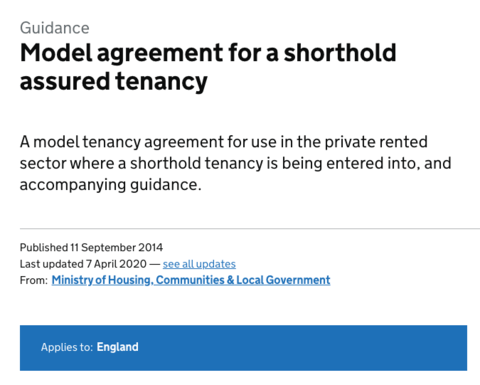As recently reported, the DCLG has produced a model assured shorthold tenancy agreement which is freely available for all to download and use. But, is it any good? Is it suitable for a professional landlord?
The agreement has been designed principally with longer tenancies (2 years or more) in mind but the break clause and rent review during the term can be removed making it more suitable for a shorter term such as 6 or 12 months.
The first thing that you notice about the agreement is that it is a whopping 38 pages in length. In fairness the typeface is fairly large and there is plenty of white-space so this could be reduced fairly simply. There is a Word or PDF version available for download.
There are positives and negatives when considering the document which is reviewed below.
Positives
Being produced by a Government department has the benefit that the clauses contained within will be arguably fair. For the avoidance of doubt, as the agreement is purely voluntary, all the clauses are subject to the The Unfair Terms in Consumer Contracts Regulations 1999 just like any other contract (indeed a couple are contrary to the unfair terms guidance, see in a moment).
The terms that are contained in the agreement appear to be clear and easily readable. There are some good guidance notes below more complex clauses where they require some explanation.
There is a useful checklist at the beginning ensuring the landlord has all the dates and reminders needed for things like gas safety record, deposit protection and such.
All the core terms that would be expected are contained within the agreement. For example there are appropriate forfeiture and grounds for possession clauses. There are a number of clauses requiring the tenant to not damage the property and to report repairs etc. In addition, there are clauses allowing the landlord entry after giving prior written notice.
Rather unusually, there are a couple of clauses which are contrary to the unfair terms guidance issued by the OFT (as it was then). The first is that the model agreement has an absolute prohibition on subletting or assignment. Such a ban may be (according to the OFT) unfair:
… we consider that, in fixed term tenancies, an absolute ban on both assignment and subletting may be considered unfair.
[Paragraph 4.23 OFT guidance]
What the guidance allows is the prohibition of subletting without the landlords consent but such consent not to be unreasonably withheld. We’ve been worried for some time about an absolute ban so recently changed our agreements to allow only very specific times within the fixed term to consider a subletting or assignment. However, we may now decide to go back to the previous version as found in the model agreement and provide for an absolute ban.
The other clause in the model agreement contrary to the unfair terms guidance is that the tenant is absolutely required to provide a forwarding address. The unfair terms guidance provides such a term is unfair and a suitable replacement would be (my emphasis):
… The tenant is asked to supply a contact address when the tenancy comes to an end.
[Page 82 OFT guidance within retention of deposit clause]
As these clauses are favourable to landlords, they are in the “positive” part of this review!
Negatives
As previously mentioned, the agreement is in our view simply too long. 38 pages is enough to put many people off! As discussed though, there may be room to squash this up a bit and we are going to look at doing this when we might cherry pick some of the clauses.
Although most of the essential core terms are contained in the model agreement, for real world lettings the clauses are inadequate in our view. Yes, they will always allow possession for non payment of rent or by way of a section 21 notice (but that doesn’t take much to do). Many clause that we would deem essential are missing.
For example, some clauses not present include:
- there is no clause requiring the tenant to keep the grass cut or hedges trimmed.
- nor are there any clauses dealing with responsibility of pests or vermin.
- the tenant is not required to keep the exterior tidy (and not display adverts etc.)
- not to change locks (without reasonable reason or permission)
There is a section at the back of the document for a landlord to add their own clauses and in fairness a gardening clause is only really needed if there is a garden. However, in my experience, untested hand drafted clauses often lead to trouble and it’s far better to have a more complete agreement to start with.
Another negative is the rule that requires a tenant to only notify if going away for longer than 28 days. This ought to be 14 days in our view because it assists when dealing with abandonment.
Finally, the model agreement specifically goes statutory periodic at the end of the fixed term. This means that prescribed information must be given again at the end of fixed term where a deposit has been taken – but only for the moment. This problem will hopefully be fixed soon and prescribed information again shouldn’t be necessary when the Deregulation Bill becomes law.
The other problem with a statutory periodic in this way is that landlords may be liable for council tax (dependant on the local authority) after a tenant has abandoned during a statutory periodic tenancy. If the agreement instead continues as a contractual periodic tenancy, this shouldn’t be a problem (although as yet untested).
Conclusion
Should a landlord use the model agreement? I think if a landlord just has one or two properties and only needs a basic agreement then the model is perfectly adequate. However, if the landlord is wanting a more professional document then I think the usual rules apply and tenancy agreements are best obtained from landlord associations, solicitors or other specialist suppliers. Of course, we would say to join a landlords association! However, we do regularly change our agreements and we react very quickly when something happens like Superstrike.
Over the next few weeks we will look more at the document and see if there is some way of integrating it into our existing agreements.





Thank you for the analysis.
I have not read the model agreement myself but regarding the requirement to provide a forwarding address I refer you to The Housing (Tenancy Deposits) (Prescribed Information) Order 2007 and S2 which covers prescribed information. S2 1 (g) (iv) states ‘the following information in connection with the tenancy in respect of which the deposit has been paid…..the name, address, telephone number, and any e-mail address or fax number of the tenant, including such details that should be used by the landlord or scheme administrator for the purpose of contacting the tenant at the end of the tenancy;’
So I guess if the landlord is taking a deposit he must record the address that should be used for the purpose of contacting the tenant at the end of the tenancy= forwarding address?
I am not overly impressed with stuff that is churned out by OFT/CMA – It is always done with good intent but often lacks the quality and sometimes a touch of reality :-)
What do you think about the requirement to state whether the property is subject to a mortgage? (Clause B3.4)
I don’t have any issue with that. All mortgage companies (that I’m aware of) require you to notify the tenant (usually by way of a ground 2 notice).
We agree with comment by Jungle Property. OFT/CMA often appear somewhat detached from “The Real World”.